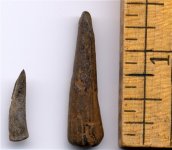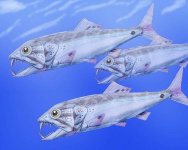tomfly
The only thing left should be foot prints.
I have been researching whether NJ has ever had a natural Atlantic Salmon run. I can not find any historical evidence to support or deny if it did or did not occur. I know NJ was colonized in the 1600s but I can find little historical evidence pertaining to fisheries from that period. I have heard a lot of hearsay over the years to support the claim that there was a run at one time. With no evidence to support it, speculation is all it is. Does anyone have any evidence to prove or disprove the mythological NJ Atlantic Salmon run?
My research did find some interesting notables.
Attempts to stock the Delaware with Salmon began as early as 1871. Stocked were 75,500 young Atlantic salmon fish in the waters in and around Easton, most likely the Bushkill, from 1871 to 1873. Five years later 15 to 20 adult fish in the grilse stage where caught in the Delaware. In 1890, The Pennsylvania Fish Commission began a serious salmon stocking program with the salmon being hatched at its new facility on the Little Lehigh. The first stocking took place as far north as Deposit NY where 60,000 fish where place in the upper streams of New York and Pennsylvania. The next year 200,000 more were released with a third and final stocking of the same amount in 1892. 1895 there was an established Atlantic Salmon run up the Delaware. There were fish caught in tributaries along the Delaware and as far north as The Beverkill and the West branch. Due to the lack of management and proper regulations the run fizzled out.
In 1874 and 1952 Chinooks, spawning adults were collected on the Raritan River . There is very little data to show how and when the Salmon were introduced into the river. Does anyone information on how these runs were started? There is very little info on the USGS’s website.
One thing good did come out of this. It did show that a salmon run can be established and with proper management could be maintained.
Not all of my research was in vain. I did find substantial evidence to prove that NJ did indeed have a have a naturally occurring salmon run. A little before our time but a salmon run none the less. During the late Cretaceous about the time that the big rock hit Salmon were spawning in NJ rivers. This fish is nothing like we have today. It is probably the grandfather of today’s Salmons species.
The Saber Tooth Salmon specimens were collected in a dig in Homedale NJ with 3 inch fangs it would have been a formidable fish. Not a fish that would be huggable. I would have been scared to wade in the river during that run. But I did find proof the NJ did have an annual occurrence of a Salmon Run

Enchodus petrosus (Cope)
Saber-Tooth Salmon
Location: Ramanessin & Big Brook, Monmouth Co., NJ

An Artist rendition of the Saber-Tooth Salmon
source material:
http://www.fossilguy.com/
http://fishingthebigd.com/index_Delaware_River_salmon.htm
http://nas.er.usgs.gov/queries/collectioninfo.aspx?SpeciesID=920
My research did find some interesting notables.
Attempts to stock the Delaware with Salmon began as early as 1871. Stocked were 75,500 young Atlantic salmon fish in the waters in and around Easton, most likely the Bushkill, from 1871 to 1873. Five years later 15 to 20 adult fish in the grilse stage where caught in the Delaware. In 1890, The Pennsylvania Fish Commission began a serious salmon stocking program with the salmon being hatched at its new facility on the Little Lehigh. The first stocking took place as far north as Deposit NY where 60,000 fish where place in the upper streams of New York and Pennsylvania. The next year 200,000 more were released with a third and final stocking of the same amount in 1892. 1895 there was an established Atlantic Salmon run up the Delaware. There were fish caught in tributaries along the Delaware and as far north as The Beverkill and the West branch. Due to the lack of management and proper regulations the run fizzled out.
In 1874 and 1952 Chinooks, spawning adults were collected on the Raritan River . There is very little data to show how and when the Salmon were introduced into the river. Does anyone information on how these runs were started? There is very little info on the USGS’s website.
One thing good did come out of this. It did show that a salmon run can be established and with proper management could be maintained.
Not all of my research was in vain. I did find substantial evidence to prove that NJ did indeed have a have a naturally occurring salmon run. A little before our time but a salmon run none the less. During the late Cretaceous about the time that the big rock hit Salmon were spawning in NJ rivers. This fish is nothing like we have today. It is probably the grandfather of today’s Salmons species.
The Saber Tooth Salmon specimens were collected in a dig in Homedale NJ with 3 inch fangs it would have been a formidable fish. Not a fish that would be huggable. I would have been scared to wade in the river during that run. But I did find proof the NJ did have an annual occurrence of a Salmon Run

Enchodus petrosus (Cope)
Saber-Tooth Salmon
Location: Ramanessin & Big Brook, Monmouth Co., NJ

An Artist rendition of the Saber-Tooth Salmon
source material:
http://www.fossilguy.com/
http://fishingthebigd.com/index_Delaware_River_salmon.htm
http://nas.er.usgs.gov/queries/collectioninfo.aspx?SpeciesID=920
